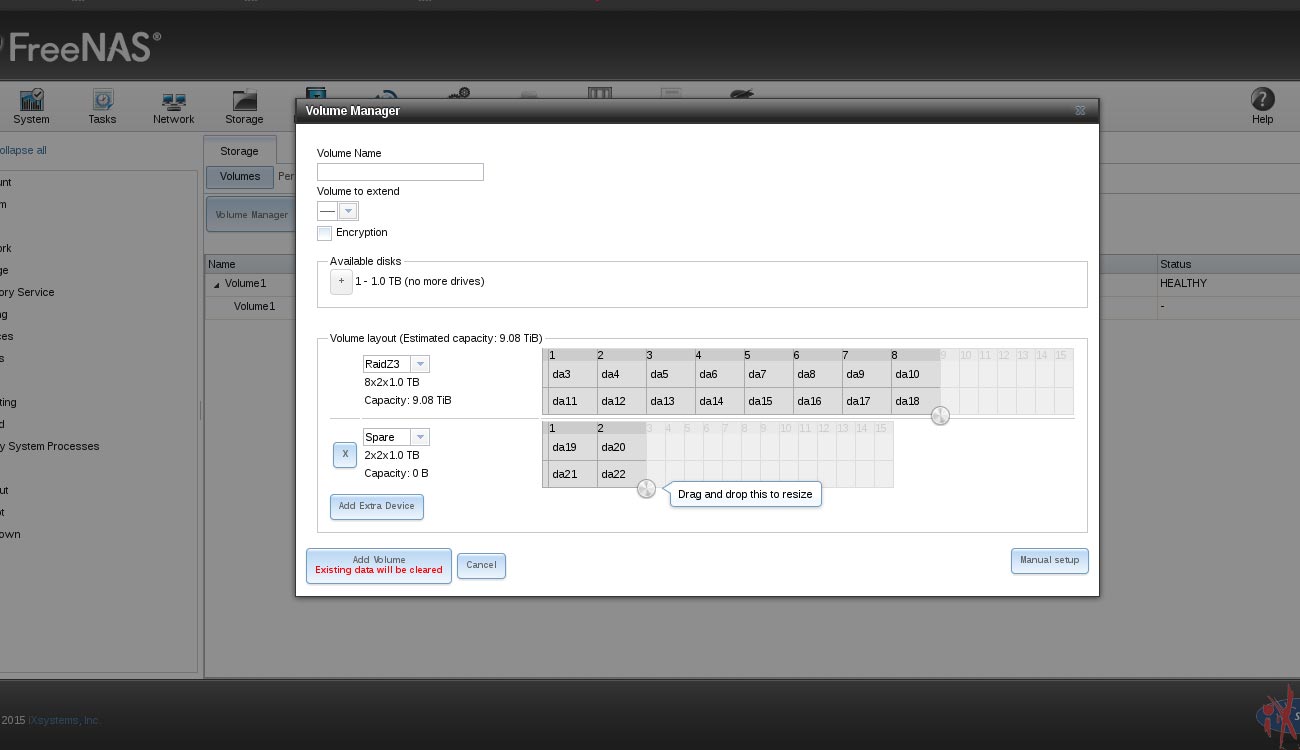Freenas Volume Manager
FreeNAS uses the ZFS file system, which supports high storage capacities and integrates file systems and volume management into a single piece of software. The benefit of using a NAS is that all your important files can be stored in a central location, allowing you to access them from multiple devices simultaneously, while also keeping our backupdata and redundancy resources in one place.
Freenas Volume Manager No Available Disks
For 18c, you may refer to: How to Build 18c RAC - 1 of 4 - Preparing Two Database Servers.
This major step describes how to build shared storage for RAC, in fact, it's for ASM to configure a disk group. This shared storage would go through NAS + iSCSI channel for servicing two RAC nodes.
Freenas Volume Manager Login
Assuming that you have installed FreeNAS 9.3 before we open iSCSI service for iSCSI clients which are two nodes of RAC server.
- No disks available in volume manager I'm having an issue attempting to create a volume in FreeNAS 11.0 U4. I'm can see the physical disc, but when I attempt to create a volume in the disc manager the disc does not show up.
- To create the ZFS RAID-Z volume, click the Storage icon in the toolbar below the FreeNAS logo. Click Create Volume, enter a Volume Name (eg. 'store') and click the disks to add to the RAID-Z set. RAID-Z needs a minimum of three disks. On my test system the three disks are called ada1, ada2 and ada3 (note that ada0 is the FreeNAS system disk).
- FreeNAS Manager is an unofficial management app that can be used to monitor and, to some degree, control a FreeNAS server. It is tested and working on FreeNAS 9.2, 9.3, 9.10 10, and 11 (see below for version-specific notes). Features: - View basic server info (IP, version etc.) - View volumes and their storage space status - Initiate scrub on volumes - View datasets and their storage space.
In this major step, we are going to have the following minor steps.
- Check the basic information about this NAS
- Create volume group and volumes for iSCSI
- Set up iSCSI Service
A. Check the basic information about this NAS
- OS: FreeNAS 9.3
- Hostname: primary-nas.example.com (192.168.15.101)
- Number of Disks for iSCSI: 4 disks.
- Space per disk: 20GB.
- Disk Redundancy: RAIDZ2 (≈ RAID 10).
- Number of ZVOL (Extents) for iSCSI service: 2.
- Number of Targets for iSCSI service: 2.
- Space per Target: 16GB.
B. Create volume group and volumes for iSCSI
See the IP address (http://192.168.15.101 in this case) of FreeNAS WebGUI indicated on the menu screen.
Open your browser to login to FreeNAS WebGUI (i.e. http://192.168.15.101 in this case.)
FreeNAS Web Login Page
Click Storage > Volume Manager
Create a volume group by dragging a 4x1 disk array with RaidZ2
FreeNAS Create RaidZ2 Volume
Click Create ZVOL icon for iSCSI extents.
Please notice that the unit of ZVOL must be in GiB, not GB
FreeNAS Create ZVOL - Dialog
OK, we have created two ZVOL for iSCSI extents.
C. Set up iSCSI Service
Start iSCSI service:- Click Services.
- Switch iSCSI service ON.
- Click the tool icon on the right side to enter iSCSI setup.
FreeNAS - Enable iSCSI Service
Create a portal for iSCSI clients to access.
Create an initiator for authenticated iSCSI clients.
FreeNAS - Add iSCSI Initiator
Create two targets asm-t1 and asm-t2.
Create two extents asm-e1 and asm-e2 by using previously created ZVOL: asm-vg1-1 and asm-vg1-2.
FreeNAS - Add iSCSI Extent
Map two pairs of target and extent.
Here is a concept worth mentioning about: The types of disk array in FreeNAS are categorized as these:

- Stripe = RAID 0 (zero redundancy)
- Mirror = RAID 1 (one redundancy)
- RAIDZ ≈ RAID 5
- RAIDZ2 ≈ RAID 10 (or RAID 1+0)
So far, the shared storage for ASM is ready.
